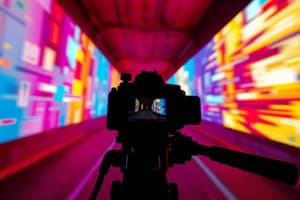Podcast
Questions and Answers
What type of camera shot provides context and frames the subject from head to toe?
What type of camera shot provides context and frames the subject from head to toe?
- Medium Shot (MS)
- Long Shot (LS) (correct)
- Extreme Long Shot (ELS)
- Close-Up (CU)
What camera angle conveys vulnerability or weakness?
What camera angle conveys vulnerability or weakness?
- Eye-Level Angle
- High Angle (correct)
- Low Angle
- Dutch Angle
What type of camera movement creates a sense of intimacy or distance?
What type of camera movement creates a sense of intimacy or distance?
- Tracking Shot
- Tilt
- Dolly (correct)
- Pan
What type of shot shows what a character is seeing?
What type of shot shows what a character is seeing?
What type of camera shot is used to show one character from behind the shoulder of another?
What type of camera shot is used to show one character from behind the shoulder of another?
What type of camera movement is used to follow the subject as it moves?
What type of camera movement is used to follow the subject as it moves?
What type of shot captures a character's reaction to a situation?
What type of shot captures a character's reaction to a situation?
What type of camera angle conveys unease or disorientation?
What type of camera angle conveys unease or disorientation?
What type of shot interrupts the main scene to show something else?
What type of shot interrupts the main scene to show something else?
What type of camera movement creates a sense of realism or urgency?
What type of camera movement creates a sense of realism or urgency?
Flashcards are hidden until you start studying
Study Notes
Camera Shots
Types of Camera Shots:
- Extreme Long Shot (ELS): Captures the subject from a distance, showing the environment.
- Long Shot (LS): Frames the subject from head to toe, providing context.
- Medium Long Shot (MLS): Combines elements of long and medium shots.
- Medium Shot (MS): Frames the subject from the waist up, emphasizing gestures.
- Close-Up (CU): Focuses on the subject's face or an object, conveying emotions.
- Extreme Close-Up (ECU): Highlights details, such as eyes or objects.
Camera Angles:
- High Angle: Camera looks down, conveying vulnerability or weakness.
- Low Angle: Camera looks up, implying power or dominance.
- Eye-Level Angle: Camera is at the subject's eye level, creating a sense of equality.
- Dutch Angle (or Canted Shot): Camera is tilted, conveying unease or disorientation.
Camera Movements:
- Pan: Camera moves left or right, following the subject or revealing the environment.
- Tilt: Camera moves up or down, emphasizing vertical elements.
- Dolly: Camera moves forward or backward, creating a sense of intimacy or distance.
- Tracking Shot: Camera follows the subject as it moves, creating a sense of dynamism.
- Handheld Shot: Camera is held by the operator, creating a sense of realism or urgency.
Specialized Shots:
- Over-the-Shoulder (OTS): Frames one character from behind the shoulder of another.
- Point-of-View (POV) Shot: Shows what a character is seeing.
- Reaction Shot: Captures a character's reaction to a situation.
- Cutaway: Interrupts the main scene to show something else, often for context.
Camera Shots
Types of Camera Shots
- Extreme Long Shot (ELS): Captures the subject from a distance, showing the environment and establishing context.
- Long Shot (LS): Frames the subject from head to toe, providing context and showing the subject's interaction with the environment.
- Medium Long Shot (MLS): Combines elements of long and medium shots, providing a balanced view of the subject and their environment.
- Medium Shot (MS): Frames the subject from the waist up, emphasizing gestures and body language.
- Close-Up (CU): Focuses on the subject's face or an object, conveying emotions and intimacy.
- Extreme Close-Up (ECU): Highlights details, such as eyes or objects, drawing attention to specific elements.
Camera Angles
- High Angle: Camera looks down, conveying vulnerability or weakness, and making the subject appear powerless.
- Low Angle: Camera looks up, implying power or dominance, and making the subject appear strong.
- Eye-Level Angle: Camera is at the subject's eye level, creating a sense of equality and neutrality.
- Dutch Angle (or Canted Shot): Camera is tilted, conveying unease or disorientation, and creating a sense of tension.
Camera Movements
- Pan: Camera moves left or right, following the subject or revealing the environment, and creating a sense of continuity.
- Tilt: Camera moves up or down, emphasizing vertical elements, and guiding the viewer's attention.
- Dolly: Camera moves forward or backward, creating a sense of intimacy or distance, and manipulating the viewer's emotional response.
- Tracking Shot: Camera follows the subject as it moves, creating a sense of dynamism and energy.
- Handheld Shot: Camera is held by the operator, creating a sense of realism or urgency, and conveying a documentary feel.
Specialized Shots
- Over-the-Shoulder (OTS): Frames one character from behind the shoulder of another, creating a sense of intimacy and relationships.
- Point-of-View (POV) Shot: Shows what a character is seeing, creating a sense of immersion, and increasing empathy.
- Reaction Shot: Captures a character's reaction to a situation, conveying emotion, and creating dramatic tension.
- Cutaway: Interrupts the main scene to show something else, often for context, and adding depth to the narrative.
Studying That Suits You
Use AI to generate personalized quizzes and flashcards to suit your learning preferences.




